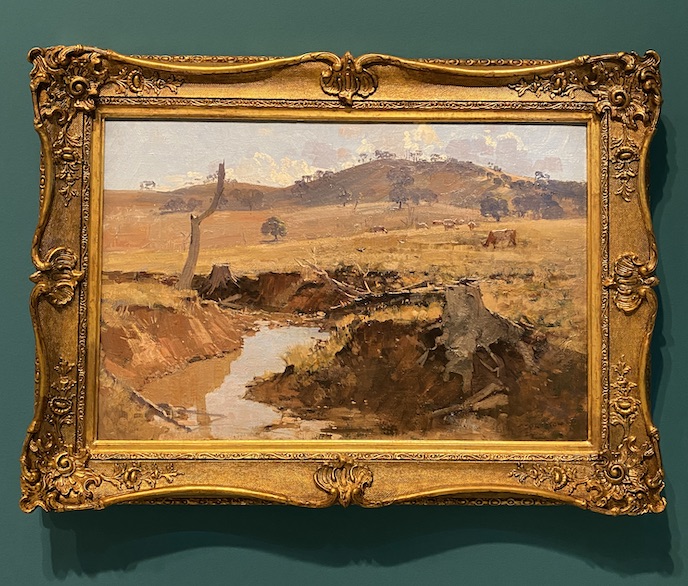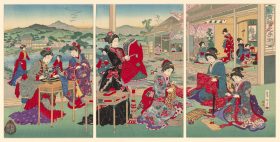Arthur Streeton is a name most of us have heard, and if not, then the likelihood is that one is familiar with his golden pastoral landscapes – those broad iconic vistas that have shaped a nostalgic Australian identity since the 1920s.
It’s rather fitting then, that curator of this exhibition, Head of Australian Art at Art Gallery of NSW, Wayne Tunnicliffe, elevates Streeton to “one-name status” with his exhibition title, as good as Madonna, Picasso, Van Gogh or Prince.
This rebadging, if you like, of our stereotype perceptions of the Australian art history giant, goes further in his facelift exhibition – the largest survey of Streeton’s work since the Gallery’s original lifetime retrospective in 1931 (this is double the size), and the last since curator Geoffrey Smith of the National Gallery of Victoria’s smaller exhibition 25 years ago.
Streeton features more than 150 paintings, drawings and watercolours spanning six decades, and drawn from 42 public and private collections, with some artworks not exhibited for more than 100 years – it is every bit worthy of the local blockbuster title.
What is most striking from the outset is that the gallery walls are painted bold colours – from saffron yellow, to burnt orange, deep teale green, to an acid lime and eventually a rich aubergine.
Tunnicliffe validated: ‘Streeton’s paintings were never designed for white walls, so we have gone all out!’ This exhibition is intended to turn us on our toes and think afresh.
Viewers are ushered in by signature works that embrace a joie de vivre – paintings created carefree en plein air with mates, the young Frederick McCubbin, Tom Roberts and Louis Abrahams at Box Hill, on the outskirts of Melbourne 1985-86.
Tom Roberts’ much loved portrait Smike Streeton age 24 (1891) understandably follows.
But it is a an intoxicating salon hang of heavily broad timber framed small zip fragments of landscapes that are the true hint of the journey Streeton was to take next. A healthy swag of paintings from the Heidelberg School sit on an orange wall, including Golden Summer, Eaglemont 1889 and Still glides the stream, and shall for ever glide (1890), restored for the exhibition.

Installation view Streeton, Art Gallery of NSW. Photo ArtsHub.
The AGNSW bought the painting at the time in 1890; Streeton was just 23. This work is an important signal to audiences – that the AGNSW supported emerging and living artists then, as it does now – a sentiment that is part of its DNA, and echoed contemporaneously with the Archie Plus exhibition upstairs, made entirely of newly commissioned works and a bridge to the next chapter with the Sydney Modern project.
This nod to the contemporary is usually couched, for Streeton, as one of the founders of Australian Impressionism. But Tunnicliffe offers a deeper view.
The teale galleries are peppered with paintings of Streeton’s adopted city – Sydney – with glorious harbour views and its rural surrounds: the Nepean, the Blue Mountains and the Hawkesbury. Curiously, as Melbourne was struggling financially, Streeton had followed his AGNSW purchase to Sydney, thinking the city had more to offer him.
From 1892 he lived at the Curlew Camp on the harbourside at Mosman; a location that has left a legacy of incredible paintings.
Central to the room, and sitting on a silver wall, is the painting Fire’s on (1891) – the stuff of textbooks and placemats. In a sea of green and blue is shines as the icon it has become.
What is surprising with this exhibition, is the way that Tunnicliffe champions Streeton as a vanguard for modern thinking right across his career. In the last galleries of the exhibition, audiences become familiar with Streeton’s passionate campaign against deforestation in the mid 1920s.
Tunnicliffe explained: ‘Those big landscapes concurrently had degraded creeks and uprooted logs. He is not against pastoralism; what he was against was the logging of old forests for paper pulp – these are contemporary narratives.’
Simply, Streeton lived a long time, and witnessed great change.
Tunniclife continued: ‘There are many parallel moments with our own time; living through economic boom and bust cycles, the great depression, the Federation of Australia, the first World War, bush fires, bush recovery, and his first book was launched in 1919 in Sydney at the height of the Spanish pandemic, so here we are a hundred hears later launching his latest book.’

Arthur Streeton, The creek (1925). Art Gallery of NSW Collection. Installation view; photo ArtsHub.
I think audiences will be surprised by the currency of these works, as our world confronts a climate crisis, and if anything liberates Streeton from the dusty hallowed halls of the Grand Courts.
Of note also, and sitting central to this enormous exhibition, is the largest showing of Streeton’s Cairo paintings presented, to date. They feel so exotic, and yet he found a connection in the light with Cairo which was much like our own in Australia.
AGNSW has 52 Streeton’s in its Collection; 32 are hung for this exhibition. The others, as AGNSW Director Michael Brand explained had to travel. ‘When a survey exhibition of this scale is curated we think of a web of international loans to bolster the gallery holdings. But we didn’t think the bigger problem would be getting these works across the border of Victoria in lockdown.’
30% of the exhibition came from Victorian collections.
This is a huge exhibition and we are lucky to have it at this moment as galleries reopen – do take the time it deserves. And as Tunnicliffe said to media gathered to preview the show: ‘We have clearly gone big! Streeton and our public deserve an exhibition like this, even more so now.’
One can only agree with Tunnicliffe. This is an exhibition that is a great affirmation of this place – the place we all share – and the narratives that shape us, past and present.
5 stars out of 5 ★★★★★
Streeton
The Art Gallery of New South Wales
Exhibition Curator: Wayne Tunnicliffe
7 November 2020 – 14 February 2021
Timed ticketing





